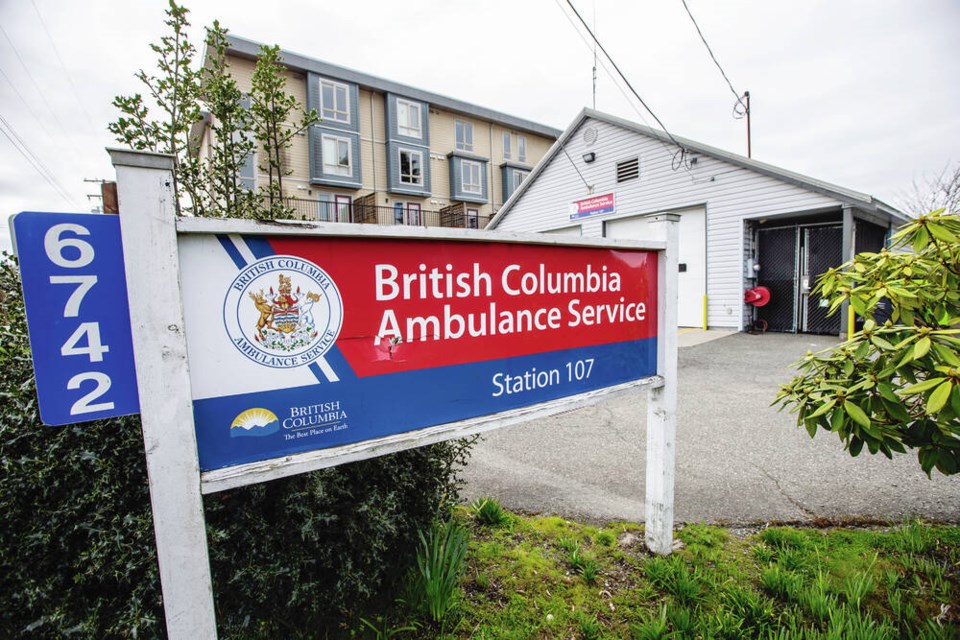Sooke Mayor Maja Tait says the B.C. Ambulance Service isn’t keeping up with growth in her community.
Sooke has one fully staffed ambulance that’s on-call 24 hours, but that vehicle and crew are often dispatched away, leaving the community vulnerable.
At times, it can be called to the West Shore because ambulances there have been sent into Victoria, in a ripple effect that’s all too common, said Troy Clifford, president of the union representing paramedics and dispatchers in the province.
“If someone’s having a heart attack in Sooke, and that ambulance has been pulled out to answer a serious call in the West Shore, that’s a concern.”
Clifford said 20 minutes of waiting for an ambulance to return could make a critical difference for someone in distress.
Tait has experienced those tense moments waiting for ambulances. In 2019, her mother needed urgent medical care and had to wait with firefighters, who provided comfort and first aid, before an ambulance arrived. She was taken to hospital, where she later died.
“If it’s a stroke or a cardiac issue or a car accident, there is a need to respond quickly,” she said. “I think our community is growing at a rate where we need an ambulance here all the time.”
Tait is also concerned that as the summer season ramps up and more visitors flow into the area, another full-time crew will be needed.
Sooke has two ambulances, but the second one is crewed with on-call staff.
B.C. Emergency Health Services, which operates the ambulance service, said it’s standard procedure for the closest paramedics to an emergency call to respond, and then return to the base as soon as possible.
Response is also based on a global medical-priority dispatch system, where patients with potentially life-threatening symptoms including chest pain, breathing difficulties, severe bleeding or unconsciousness get care first, a spokeswoman for B.C. Emergency Health Services said in a statement.
Clifford said outlying ambulances being called into larger centres is a problem up and down the Island, noting Peninsula-based ambulances are often called away, and it’s the same around centres such as Duncan, Nanaimo and Courtenay.
He said more resources should be allocated in the larger centres, so smaller communities like Sooke are left alone.
The B.C. Ambulance Service responded to more than a million calls last year, up from 714,000 in 2018. “These numbers are just not sustainable,” Clifford said.
The province could use another 500 paramedics, he said, but like most employers, the ambulance service is experiencing a shortage of trained workers. It’s also competing for newly trained paramedics with construction, road building, and forestry and mining companies, he said. “I know of lots of people who want to be paramedics and they are getting the training, but private industries are offering more, including meaningful wages.”
B.C. Emergency Health Services said although it has faced staffing challenges during the pandemic, it has hired plenty of paramedics over the past year — 85 full-time paramedics in urban communities and 177 to support the transition to full-time, 24/7 staffing in 24 rural stations, among other hires.
Sooke gained seven new permanent, full-time positions to staff an ambulance 24/7. Previously, during some hours of the day, that ambulance was staffed by paramedics who were on standby at the station, making minimum wage for the period they were on standby and full wages while out on calls.
In Sooke, the ambulance service is responding to an increasing number of medical emergencies: from 1,503 in 2019 to 1,853 last year.
When ambulances aren’t immediately available, firefighters are increasingly responding to medical calls.
Matt Barney, deputy chief of Sooke Fire Rescue, said the department responded to more than 500 medical aid calls last year, which made up nearly 60% of the firefighters’ workload. Sooke has an eight-member fire department.
Barney said the general rule is that if an ambulance is more than 10 minutes away, the fire department will respond. B.C. Emergency Health Services said it notifies firefighters of all critical calls, so they can provide first aid such as CPR and monitor the patient until paramedics arrive.
Barney said firefighters often wait with those in need for 15 to 20 minutes before the ambulance arrives. Those ambulances might be on their way back from calls in Victoria or East Sooke, or could be doing a patent transfer from the Port Renfrew ambulance.
“Sometimes it’s just a matter of providing that emotional support and provide that comfort that can help bring their blood pressure down and reduce the very stressful situation they are in.”



